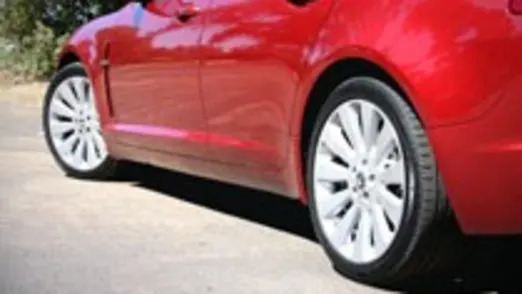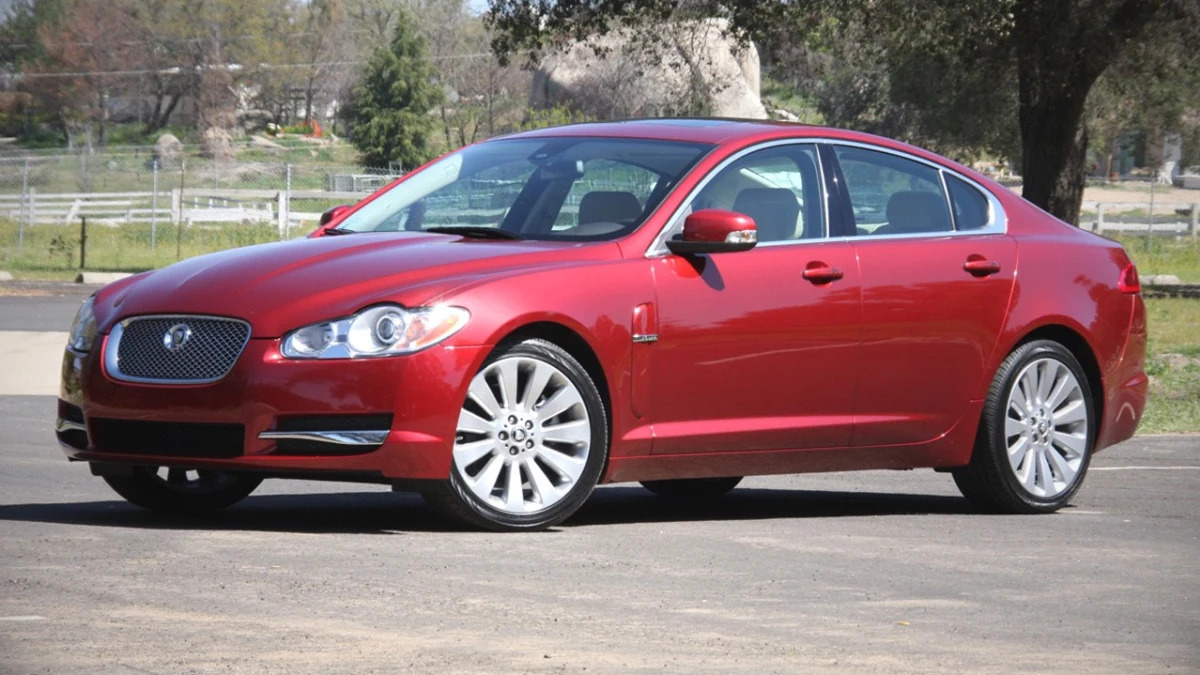2009 Jaguar XF – Click above for high-res image gallery
The timing of our first hands-on experience with the Jaguar XF is, to say the least, awkward. Less than a week after Ford agreed to sell both Jaguar and Land Rover to India's Tata Motors, we find ourselves in sunny San Diego behind the wheel of Jag's supposed savior. While the business end of the equation will be exhaustively covered in the coming months, the renaissance underway at Tata's newly acquired pet is of equal importance. The XF is a serious step on the road to recovery, but undoing the perception gap that's plagued this cat for the last couple of decades won't be easy.
All photos © 2008 Damon Lavrinc / Weblogs, Inc.
Among the myriad issues Jaguar has to overcome, the greatest is attracting young consumers into the fold. While the average age of a modern Jag buyer isn't nearly as high as a Buick's, it is still rare to see someone behind the wheel that isn't well on his or her way to collecting Social Security. Unfortunately, this kitty got neutered when it made the transition from concept to production. If there's anything that's going to draw new, youthful buyers to the brand, it's sinuous sheet metal that blends balance and bling. The XF just doesn't have it. The new Jag floats in an air of anonymity that may cause a few people to take notice, but it won't produce the neck trauma normally induced by Ian Callum's designs.

Viewed from afar, nothing seems to stand out. The beltline is high enough to convey the sedan's sporting intentions and the haunches that flow into the taillights are attractive enough -- in a watered-down, Aston Martin-sorta way. But you get the sense that the majority of the design took place a few inches from the clay, rather than taking in the vehicle as a whole. This approach, while doing little for the XF overall, has its benefits. The fluting that begins aft of the headlamps and flows into the hood is a nice touch, and the C-pillar is almost a dead-ringer for the XK. But as well-proportioned as everything is, nothing grabs your attention by the collars and screams at you like a drunken drill instructor on leave.


The interior is another issue entirely. The fit, finish and execution are totally unmatched in this highly competitive class and we can say with impunity that nothing short of a Roller or a Bentley comes close to the design and materials inside the XF. The top of the dashboard benefits from a double dose of stitching that flows from door to door, while underneath an aluminum belt encompasses occupants and blends some 21st century styling with the old-world feel of acres of wood. Chris Braeendale, one of Jaguar's marketing crew, says there's more wood in the XF than in the 1962 Mk. II, and we believe him. But its execution doesn't suffocate inhabitants like the XJ and its predecessors.

While our assessment of the exterior confirms Callum's creed that more designers were tasked to work on the interior than the metal surrounding it, it is obvious that OCD-levels of focus were paid to how the driver and passenger interact with the electronics. The very large central-mounted touch screen is standard equipment on all XFs, and controls everything from the satellite navigation to the stereo. An iPod connector integrates directly into the system and allows navigation through playlists, artists, albums and more, while a USB input and a standard auxiliary jack can be used for other portable media devices. We even took a moment to hook up our iPhone to the system, play a few tracks from The Bravery and make a quick call from our contacts list through the Bluetooth connection – all of which worked seamlessly. Jaguar's interior boffins were also smart enough to place a volume control knob, track selection and audio source buttons into the console below to avoid iDrive-levels of frustration, along with redundant stereo controls mounted on the steering wheel.


It's unfortunate that the simple, elegant execution of the electronics is playing second fiddle to the pseudo-dramatic JaguarDrive starting sequence. Depress the brake, push the pulsating start/stop button at the top of the center console, and the rotary gear selector rises into the palm of your hand while the air vents slowly spin into place. From there, you can select from your normal assortment of gears (P, R, N and D), and with a slight press down and a twist to the right, you're in Sport mode. The whole process is impressive the first, second and third time, but after a while it is just another routine that will likely lose its allure after you've show it to the neighbors. What's more impressive is the JaguarSense system. Rather than grabbing a handle to open the glove box or pushing a button to turn on the map lamps, a proximity sensor allows you to glide your finger overtop the light (or the circular sensor mounted on the dash for the glove box). The system worked flawlessly with the overhead lights, but the glove box control needed a more deliberate action due to the sensor's programming to avoid unnecessary openings. Here's hoping that it works as intended when a boy in blue is waiting for your insurance and registration.


Our only gripes with the interior were the sharp edges underneath the steering wheel's aluminum trim and the JaguarDrive's somewhat shifty feel. This might be an issue with the production models we were given for our road test, but both the transmission selector and the rotary knobs for the stereo and climate control felt like they needed a bit more refinement before they were ready for primetime placement.
Once properly positioned in the driver's seat, it's obvious that Jag is taking serious aim at the sports sedan segment. The seats are nicely bolstered without inhibiting movement and when coupled with the high center console that bisects the front seats, there's a serious sense of focus that's been missing from Jags for far too long.

We opted to start our drive with the naturally aspirated XF, which produces 300 hp and 310 lb.-ft. of torque from ye-old 4.2-liter, V8 mill. With the futuristic gear selector in Drive, we made our way out of the confines of central San Diego and onto the nearest freeway, bound for the rolling hills that separate civilization from the deserts that surround the area.
Cruising along at 75 mph on the highway, the XF proves that Jaguar has done its best to strike a balance between handling and comfort. The suspension's compliance over bumps and breaks is perfectly suited for long-distance cruising, but not at the expense of road-feel. The steering's on-center tactility is only matched by its crisp turn-in and balanced weighting, and while it's a little over-boosted around town, turning at speed is inspiring and instantaneous; we just wish the diameter of the wheel was about an inch shorter.


After our brief jaunt on the motorway, we found ourselves on the most gloriously twisting tarmac this side of Highway 1. Here, the XF truly came into its own. With the gear selector set to sport and the traction control in TracDSC (allowing for minimal amounts of wheel slip), the Jag consumed the road in quick order. The six-speed ZF automatic transmission reacts swiftly to hard acceleration inputs with shifts that are 15-percent quicker than those in the XK. However, the paddle shifters were what truly impressed. With a light pull back on the lever, the tranny drops down a gear, simultaneously blipping the throttle and providing a seamless transition as we brake before the corner. Turn-in, start feeding in the throttle and the lack of an aural assault is countered by the healthy amount of thrust propelling us through the bend. By the time we've reached 6,000 rpm, the transmission's computers are ready to deliver the next gear as we hustle along to the next turn. After a handful of bends, we're convinced that the XF is one of the best handling sedans for the money. But what about that Frost Blue model with the "Supercharged" badges?

You can spec the "Luxury" and "Premium Luxury" XF with many of the interior amenities of the maxed-out supercharged version, including the Bowers and Wilkins, 440-watt, 14-speaker audio setup, which, for the record, is pure ear-porn. But you can't get Jaguar's Computer Active Technology Suspension (CATS) or the Dynamic Mode that integrates with the electronically controlled, two-stage adaptive dampers without making the leap to the forced-induction model. The Dynamic Mode fully exploits the XF's unflappable chassis and allows you to run the blown, 4.2-liter V8 up into its rev-limited 6,500-rpm peak.


Caning the supercharged version through the bends with the checkered-flag button depressed, you can feel the rear suspension firming up as weight transfers to the front under braking. Through the turns, it is obvious that the adaptive suspension is working its magic, but it's more intuitive than intrusive. With 420 hp and 414 lb.-ft. of torque being shuffled between the rear wheels, the XF has no trouble getting out if its own way, but the deft touch and communicative steering seems somewhat lost compared to its naturally-aspirated sibling. While the immediate thrust and slightly more aggressive exhaust note is endearing, the 200-pound weight penalty caused a bout of regret that we wouldn't be spending more time behind the wheel of the standard model.

Sales of the XF began last month and with 4,000 preorders, Jag's new keeper may already have a hit on its hands. Pricing is aggressive for the segment, with the Luxury model coming in at $49,975, the Premium Luxury variant set at $55,975, and the supercharged version carrying a sticker of $62,975. For those of you who can't wait for the XF-R due out sometime next year, it's simply a matter of choosing which features you value most, and being content with the knowledge that whatever version you choose, you'll be able to enjoy the most engaging vehicle ever produced by Jaguar while helping to reestablish the storied marque as a forward-thinking purveyor of one of the world's finest sedans.
All photos © 2008 Damon Lavrinc / Weblogs, Inc.
Our travel and lodging for this media event was provided by the manufacturer.



Sign in to post
Please sign in to leave a comment.
Continue